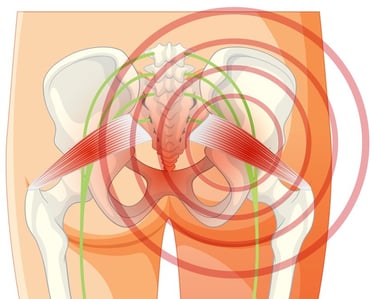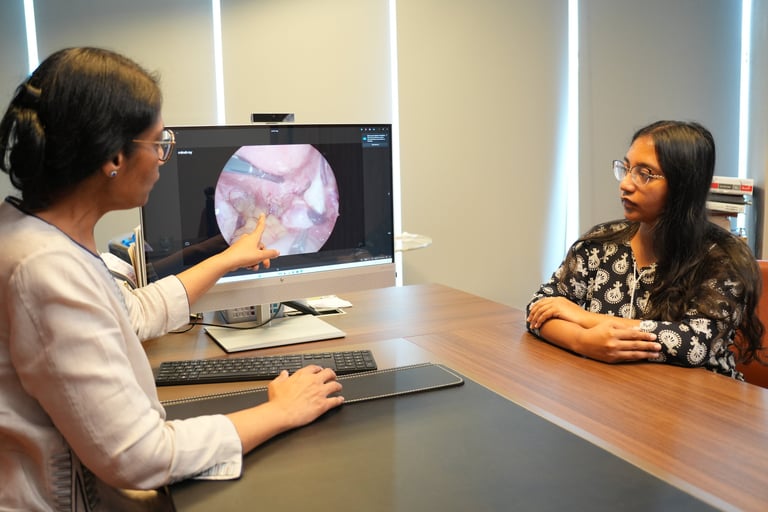Endometriosis Nerve Pain? What Many Women Don’t Realise
Endometriosis nerve pain is often misdiagnosed as sciatica or slipped disc. Learn how endometriosis affects nerves and how early diagnosis can relieve chronic pain.
Dr. Smita Sinha
8/16/20254 min read


Can Endometriosis Cause Nerve Pain?
Endometriosis affects roughly 1 in 10 women of reproductive age—but its impact goes far beyond period pain and fertility issues. In some women, the condition can also cause unexplained nerve pain that spreads to the back, legs or pelvis. As a result, many patients spend years being treated for sciatica, slipped disc or general muscle pain—without getting any better.
This article explains how endometriosis nerve pain happens, why it often goes undiagnosed, and what steps you can take if you suspect that nerve pain could be linked to endometriosis.
What is Endometriosis?
Endometriosis is a chronic inflammatory condition where tissue similar to the lining of the uterus (endometrium) grows outside of the uterus. These abnormal deposits most commonly affect the ovaries, fallopian tubes, and pelvic lining. During the menstrual cycle, this tissue responds to hormonal changes and can bleed, become inflamed, and form scar tissue—leading to pain and other long-term complications.
Most people associate endometriosis with severe period cramps and infertility, which are the two most common symptoms. However, endometriosis nerve pain is now increasingly recognised as another manifestation of the condition.
Why Is It Often Misdiagnosed?
One of the biggest challenges in diagnosing endometriosis nerve pain is that many patients do not have classic gynaecological symptoms. For example, a woman may complain of severe leg pain, but her periods are only slightly painful. Because of this, she might be referred to an orthopaedic specialist or a neurologist instead of a gynaecologist.
In many cases, MRI or CT scans of the spine appear normal, which further delays the correct diagnosis. It is only when the pain is found to worsen during menstruation—or when other symptoms such as pelvic pressure or infertility appear—that the possibility of endometriosis is finally considered.
Signs That Nerve Pain May Be Caused by Endometriosis
If you have been experiencing persistent nerve pain without a clear diagnosis, it is worth considering whether it could be related to endometriosis. The following signs may provide useful clues:
Pain occurs in a cyclical pattern (worse before or during your period)
Pain begins in the pelvis and radiates to the back, hip or leg
You have a history of painful periods or struggled to conceive
Standard treatments for sciatica or back pain have not helped
Numbness or tingling is triggered by hormonal changes during your cycle
If several of these symptoms apply to you, endometriosis nerve pain could be the underlying cause.
📞 Need Help?
To speak with a compassionate and experienced specialist, contact Dr. Smita, Consultant Gynaecologist at KPJ Selangor Specialist Hospital, Shah Alam.
💬 WhatsApp us at +60165833302 to book an appointment and get the personalised care you deserve.






How Can Endometriosis Affect the Nerves?
Endometriosis doesn’t always stay near the reproductive organs. In many cases, the tissue can grow deeper into the pelvis and involve important nerves that run through the lower back, buttocks, and legs. When this happens, it may irritate or compress the surrounding nerves—resulting in sharp or shooting pain, numbness or muscle weakness.
Some of the major nerves that may be affected and their respective possible symptoms include:
Sciatic nerve: Lower back pain, pain radiating down the leg, tingling or numbness
Obturator nerve: Inner thigh or groin pain, weakness in hip movements
Pudendal nerve: Pelvic pain, pain during sitting, pain in the genital area
Femoral nerve: Front thigh pain, knee weakness


Final Takeaway
Endometriosis nerve pain is real—and often overlooked. If you have been living with unexplained nerve pain, especially one that worsens during your period, don’t ignore it. Early recognition and the right treatment can make a significant difference.


What Happens If It Is Left Untreated?
Leaving endometriosis nerve pain untreated not only leads to ongoing discomfort but may also result in long-term nerve damage and reduced quality of life. Patients may find it difficult to exercise, sit for long periods, or carry out daily activities due to the constant pain and muscle weakness. In some cases, untreated nerve-involving endometriosis may even reduce fertility.
This is why early diagnosis and the right treatment plan are so important.


What You Can Do
The good news is that endometriosis nerve pain can be managed effectively when it is properly diagnosed. Here are some practical steps to take:
1. Track Your Symptoms
Keep a record of your pain—when it occurs, where it spreads, and whether it changes during your menstrual cycle. This will help your doctor identify possible hormonal links.
2. See a Gynaecologist Who Has Experience in Endometriosis
Not all specialists are trained to recognise nerve involvement. A gynaecologist with experience in complex endometriosis can evaluate your symptoms and order the right imaging tests (such as pelvic MRI or nerve-focused scans).
3. Consider Advanced Imaging
Standard spine scans may appear normal. However, a targeted pelvic MRI can detect deeper lesions that involve the nerves.
4. Get a Personalised Treatment Plan
Treatment options may include hormonal therapy to reduce inflammation, or excision surgery to remove the endometriosis tissue affecting the nerve. Excision surgery has been shown to improve pain and nerve function in many patients.


Contact Us
Clinic: +60355433285
Whatsapp: +60165833302
Email: smitaobgyn@gmail.com


Why Us?
About Us
Services
Endometriosis
Robotic Surgery
Articles
